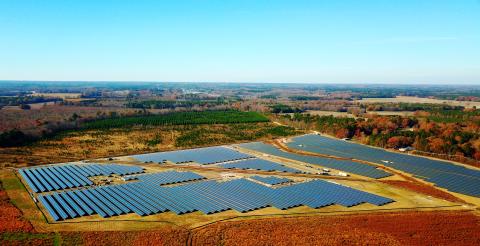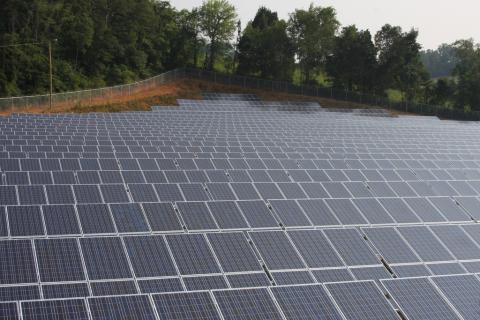Unlocking Solar Energy’s Potential in the Aggregates Industry: Insights from Ed Rottmann of Chroma Energy Group
By Libby Pritchard, NSSGA
In pursuing cost efficiency and sustainability, industries increasingly turn to renewable energy sources. Among these, solar energy is an up-and-coming solution for the aggregates industry. To learn more, I caught up with Ed Rottmann, CEO of Chroma Energy Group, who founded the company after over a decade with Caterpillar, getting to know the aggregates industry and its energy needs.

How can solar energy benefit the aggregates industry in terms of cost savings and sustainability?
Solar energy is a perfect fit for the aggregates industry. When working with commercial and industrial customers, we look at a few key benefits they can get from solar energy: economics, sustainability, increased energy resiliency and the utilization of available land or space to place the system. When an industry checks all four boxes, that’s a fantastic fit. First, aggregate companies use a lot of electricity to run their operations, so reducing the amount they pull from the utility company can have a dramatic economic impact, especially during afternoons when production is usually high, and an aggregate operator pays top dollar for their energy. Second, a lot of aggregate companies also have aggressive sustainability goals and using solar energy is a great way to reduce their carbon footprint and help them reach these goals. Third, solar can increase power resiliency, which is especially helpful if a quarry experiences rolling blackouts or brownouts, curtailing operations due to loss of electricity or looking to mitigate costs during peak hours. Last, many quarries have land they may not be mining for 30 years, which is the life of a solar installation.
What are some key considerations and options for operators considering solar energy?
First, we need to consider whether a system will be solar, battery or a combination. There are two data points a utility company charges on: the total kilowatts used in a month and demand charge. When you just use solar, you are reducing the total amount of energy consumed from the utility company because solar will supplement your energy needs, as it produces a lot of energy, typically from 10 a.m.-5 p.m. Whereas when you install batteries, quarries will typically discharge that electricity during peak consumption times to reduce demand charges. For example, quarries often experience peak consumption in the morning when they fire up, but that is not typically when solar is producing a lot of electricity. So, quarries can install microgrids that charge batteries with solar energy and then use those batteries during peak times to offset demand charges.
Quarries also must decide if they want to own the system or work with a developer who will finance it, own it, and typically require the operator to sign a power purchase agreement (PPA) where both parties agree to a kilowatt per hour charge, which the quarry will buy from the developer. Owning a system gives the operator the full depreciation, tax credits, ownership of the renewable energy credits (RECs) and full control to maximize the economic value of the system, which is why we usually recommend ownership if the system is a good fit, but there is a capital investment, so some operators still choose to work with a developer.
Even on cloudy days, there is solar production and systems that can hit their ROI goals. For example, the northeast U.S. has aggressively adopted solar and is not seeing much downside in production, even though their winters are rough. There really aren’t any "bad places" for solar.
How do operators get started and what does integrating solar energy into an existing quarry look like?
One of the first things that must be done is a site viability assessment. This includes a review of where the solar field could be located, how easy it is to tie the system into the electric panel, the capacity of the existing panel and an analysis of utility bills to figure out what the payback period and ROI will be. It is also essential to work with the local utility company to facilitate a buyback provision on excess electricity, so during the afternoon, during peak production, the operator will sell energy back to the grid; this can dramatically impact the ROI of a system. The viability assessment costs vary depending on the project, particularly if there are several sites to be assessed, but range from $800-$5,000 and provide a detailed economic and financial analysis of exactly what the system will produce, savings on utility bills, system design, and layout and a rough order of magnitude quote.
Once the site assessment has been done and the location is final, we go back and forth with the operator in the design stages to draw up the whole system. After that is finalized, we file for permits, conduct any civil engineering needed, install the system, do the interconnection (tie it into the existing system), test and finally commission it and turn it on—the solar system starts producing energy on day one. The whole process, from site assessment to commissioning, takes roughly eight months.

What funding opportunities and incentives should operators be aware of if they are looking to invest in solar energy?
A lot of people are familiar with the depreciation benefits, which is up to 85 percent accelerated depreciation and the investment tax credit (ITC), which is 30 percent of the total system cost as a tax credit. However, not a lot of people are familiar with the additional credits. For example, there is a low income community credit for certain geographic areas that meet poverty and unemployment level requirements to qualify for an additional 10 percent tax credit (capped tax credit). There is also a domestic content tax credit of 10 percent if all structural steel and/or iron plus at least 40 percent of the total cost of manufactured products used were mined, produced or manufactured in the U.S. Finally, there’s an energy community 10 percent tax credit locations can qualify for if they meet one of three requirements around coal, oil or natural gas. We’ve found a surprising number of quarries qualify for one or more of these additional credits.
Looking to the future, what trends and advancements do you see on the horizon for solar energy?
The cost of solar energy has been falling for the last decade and continued research and development in the renewable energy and storage space is going to continue to drive prices down. There is a tremendous amount of onshoring going on with materials and components, and we expect prices to keep going down and systems to get better and better. Beyond lower cost and improved performance, the most significant innovations will be in storage. Batteries and storage are going to play a bigger and bigger role in systems going forward. But there are new technologies in solar panels too—polyciliate is typically what modules are made of, but there is a new material called perovskite made from titanium oxide that produces flexible modules that can be rolled, and they are tougher than traditional modules.
Originally published in July/Aug. 2024 Stone, Sand & Gravel REVIEW.

